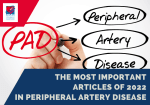One of the challenges of percutaneous coronary interventions (PCI) are <2.5 mm vessels, since complications and restenosis complications rate are higher than with >3.0 mm vessels. Drug Coated Balloons (DCB) can be a useful tool, but their efficacy and safety [vs. plain old balloon angioplasty] remains unclear. PEPCAD China SVD is a prospective and multicenter<a href="https://solaci.org/en/2023/02/06/can-drug-coated-balloon-be-a-valid-option-for-small-vessels/" title="Read more" >...</a>
POKI: A New Bifurcations Strategy
This scientific article we briefly discuss the POKI technique, a new stent optimization strategy for bifurcation lesions. Coronary bifurcations represent 20 to 25% of percutaneous coronary interventions (PCI) and continue to be a real challenge at present; the different available treatment strategies are used to correct bifurcation carina after stenting seeing as incomplete strut apposition<a href="https://solaci.org/en/2023/01/27/poki-a-new-bifurcations-strategy/" title="Read more" >...</a>
FRAME-AMI: FFR vs. Angiography of Non-Culprit Vessel in ACS
This study compared fractional flow reserve (FFR) vs. angiography to guide the angioplasty of non-culprit vessels in patients with acute coronary syndrome (ACS) and multivessel disease. Landmark studies such as COMPLETE, COMPARE-ACUTE and DANAMI-3-PRIMULTI have demonstrated the prognostic value of revascularization (after treatment of the artery responsible for the ACS) of non-culprit arteries with respect<a href="https://solaci.org/en/2023/01/25/frame-ami-ffr-vs-angiography-of-non-culprit-vessel-in-acs/" title="Read more" >...</a>
The Most Important Articles of 2022 in Peripheral Vascular Disease
Discover the most important scientific articles of 2022 in peripheral vascular disease in our website. EMINENT Trial | Stent Eluvia vs BMS in Femoropopliteal Territory Endovascular therapy in femoropopliteal territory has become the standard, mainly with self-expanding stents, aimed at preventing early vascular recoil and late constrictive remodeling. Thromboendarterectomy vs. Endovascular Therapy in Common Femoropopliteal<a href="https://solaci.org/en/2023/01/19/the-most-important-articles-of-2022-in-peripheral-vascular-disease/" title="Read more" >...</a>
Is it Possible to Reduce DAPT Time in Diabetic Patients?
Short-duration dual antiplatelet therapy (DAPT) after percutaneous coronary intervention (PCI) with DES is growing steadily, especially for chronic coronary syndromes. There is also some evidence regarding its use in acute coronary syndrome. However, diabetes is a well-known risk factor for both restenosis and thrombosis, since it involves more complex and longer lesions in vessels that<a href="https://solaci.org/en/2023/01/18/is-it-possible-to-reduce-dapt-time-in-diabetic-patients/" title="Read more" >...</a>
Intervention in Patients with Takayasu Arteritis: Rescue Therapy or an Alternative Complementary to Immunosuppressive Therapy?
Takayasu arteritis (TAK) is an uncommon granulomatous large-vessel vasculitis that affects the aorta and its primary branches. The most frequently types of observed vascular compromise are obstructive lesions, and aneurysmal vascular lesions or dissections. In 2021, the American College of Rheumatology recommended not to implement percutaneous intervention (PI) with these patients and only use immunosuppressive<a href="https://solaci.org/en/2023/01/18/intervention-in-patients-with-takayasu-arteritis-rescue-therapy-or-an-alternative-complementary-to-immunosuppressive-therapy/" title="Read more" >...</a>
The Most Important Articles of 2022 in Structural Heart Disease
Discover the most read scientific articles on interventional cardiology of 2022 in our website. We Should Treat Significant Stable CAD in Patients Undergoing TAVR Aortic stenosis is associated to significant coronary artery disease (CAD) in nearly 50% of cases. When we decide to treat aortic disease using surgery, it has been established we should also treat<a href="https://solaci.org/en/2023/01/12/the-most-important-articles-of-2022-in-structural-heart-disease/" title="Read more" >...</a>
Invasive Myocardial Viability Indexes
From a cellular standpoint, the term ‘myocardial viability’ refers to a myocyte that has no irreparable damage. From a clinical standpoint, it refers to areas with myocardial contractile dysfunction at rest that are expected to improve with correct revascularization. There are specific vessel ischemia and viability indexes that may help identify hibernation areas that could<a href="https://solaci.org/en/2023/01/10/invasive-myocardial-viability-indexes/" title="Read more" >...</a>
Interventional cardiology: the most read articles of 2022 in solaci.org
Discover the most read scientific articles on interventional cardiology of 2022 in our website. The FDA Approves Intravascular Lithotripsy for Calcified Lesions The US Food and Drug Administration (FDA) has cleared the shockwave lithotripsy system to treat severely calcified plaque lesions. Is Epinephrine Superior to Adenosine in No-REFLOW? In patients with acute coronary syndrome, no-reflow prevalence is 32%. Different drugs—such as adenosine, verapamil,<a href="https://solaci.org/en/2023/01/05/interventional-cardiology-the-most-read-articles-of-2022-in-solaci-org/" title="Read more" >...</a>
We Should Treat Significant Stable CAD in Patients Undergoing TAVR
Aortic stenosis is associated to significant coronary artery disease (CAD) in nearly 50% of cases. When we decide to treat aortic disease using surgery, it has been established we should also treat heart disease. However, when using transcatheter aortic valve replacement (TAVR), this is still unclear, given that in many occasions we see stable lesions<a href="https://solaci.org/en/2022/12/30/we-should-treat-significant-stable-cad-in-patients-undergoing-tavr/" title="Read more" >...</a>









